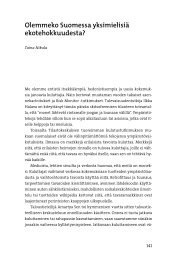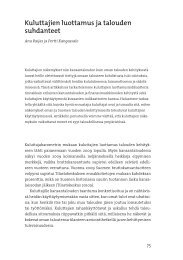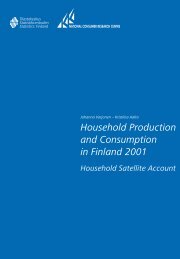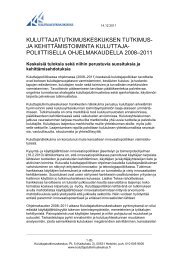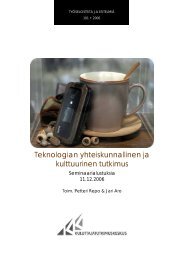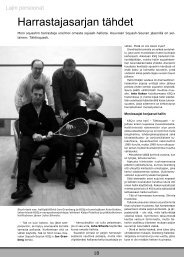Household Production and Consumption in Finland 2001
Household Production and Consumption in Finland 2001
Household Production and Consumption in Finland 2001
You also want an ePaper? Increase the reach of your titles
YUMPU automatically turns print PDFs into web optimized ePapers that Google loves.
4.3 Pr<strong>in</strong>cipal functions of household production<br />
As mentioned before, the <strong>Household</strong> Satellite Account aims give a mean<strong>in</strong>gful<br />
overview of household production. For this reason it makes sense to allocate<br />
the household’s numerous activities to a few core areas. Similar classifications<br />
are used for the functions of general government, for example (COFOG:<br />
education, health care, environmental protection, defence, etc.) 5 . The<br />
<strong>in</strong>ternational research <strong>and</strong> education tradition <strong>in</strong> the field of home economics<br />
makes a dist<strong>in</strong>ction between economic, social <strong>and</strong> cultural functions of<br />
households <strong>and</strong> families. The economic function is further divided between<br />
productive activities <strong>and</strong> consumption <strong>and</strong> sav<strong>in</strong>g. The social function deals<br />
with relationships between household members <strong>and</strong> their socialisation with<br />
the surround<strong>in</strong>g community. The cultural function of households, then,<br />
consists <strong>in</strong> the development of household members’ <strong>in</strong>tellectual capacities, the<br />
ma<strong>in</strong>tenance of community values <strong>and</strong> cultural heritage <strong>and</strong> h<strong>and</strong><strong>in</strong>g them<br />
down from generation to generation (e.g. Blosser-Reisen 1975, Hallman<br />
1991).<br />
The <strong>Household</strong> Satellite Account focuses on the economic function. S<strong>in</strong>ce<br />
the economic, social <strong>and</strong> cultural functions are <strong>in</strong> practice closely <strong>in</strong>terwoven,<br />
the economic component is dist<strong>in</strong>guished from the others us<strong>in</strong>g the third party<br />
criterion. Unpaid work is valued only as an economic activity (if the work were<br />
done by someone else, how much would it be worth); any other objectives<br />
embedded <strong>in</strong> this activity are ignored, as whether unpaid work is liked or not<br />
(Goldschmidt-Clermont 1994).<br />
Analyses of economic functions <strong>in</strong> the household sector have traditionally<br />
applied an activity-based classification. Classifications applied <strong>in</strong> time use<br />
surveys are based on this same tradition as far as unpaid work is concerned.<br />
Even before EU-harmonised classification, domestic work <strong>in</strong> time use surveys<br />
<strong>in</strong>cluded the follow<strong>in</strong>g activities: provid<strong>in</strong>g meals, family <strong>and</strong> childcare, sew<strong>in</strong>g<br />
<strong>and</strong> care of clothes, hous<strong>in</strong>g-related activities as well as shopp<strong>in</strong>g <strong>and</strong><br />
management. Hous<strong>in</strong>g-related activities have been grouped <strong>in</strong> various ways,<br />
but most classifications <strong>in</strong>clude clean<strong>in</strong>g, repairs <strong>and</strong> garden<strong>in</strong>g. Travel related<br />
to unpaid work is rarely mentioned separately; it is obviously <strong>in</strong>cluded <strong>in</strong> the<br />
activity that it serves (see Kilpiö 1981, 68-69) 6 . On the basis of this tradition<br />
the pr<strong>in</strong>cipal functions of household production were developed (Ironmonger<br />
1997 <strong>and</strong> Varjonen et. al. 1999). Similar description of household production<br />
has been used <strong>in</strong> the UK, Basque <strong>and</strong> Hungarian household satellite accounts<br />
as well as <strong>in</strong> calculat<strong>in</strong>g the value of unpaid work <strong>in</strong> New Zeal<strong>and</strong> <strong>and</strong><br />
Australia.<br />
5 The Classification of the Functions of Government, COFOG, is used for describ<strong>in</strong>g economic<br />
activities <strong>in</strong> the public sector. The classification is <strong>in</strong>cluded <strong>in</strong> the United Nations System of<br />
National accounts (SNA) 1993.<br />
6 The classifications described by Kilpiö were drawn from the follow<strong>in</strong>g studies: Cowles & Dietz<br />
1956, O<strong>in</strong>onen 1973, Walker & Woods 1976, Rob<strong>in</strong>son 1977, Konsumentverket 1977.<br />
24 Statistics F<strong>in</strong>l<strong>and</strong> National Consumer Research Centre




